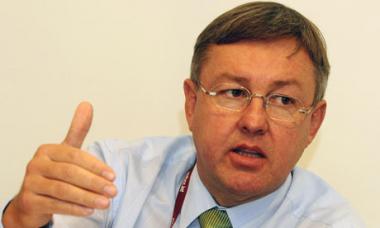SA’s hotel Industry in need of drastic boost
 Tourism minister Marthinus van Schalkwyk has announced an Industrial Development Corp audit of underutilised state properties for development into tourist attractions.
Tourism minister Marthinus van Schalkwyk has announced an Industrial Development Corp audit of underutilised state properties for development into tourist attractions.
SA’s hotel industry is emerging from a difficult period characterised by a combination of oversupply and lower demand.
Protea Hotels CEO Arthur Gillis is not happy about the 60% room occupancy across SA’s hotel industry. Falling bookings from SA’s traditional international arrivals and local business in the downturn exposed hotel oversupply after the 2010 soccer World Cup.
“Now we have price wars, sometimes down to R250/night,” said Gillis at the Hotel Investment Conference Africa (Hica) in Durban. “I defy anyone who’s not a money-laundering specialist to make money on that.”
He believes 1200-bed hotels generally aren’t profitable at even R600/night. Location is often the problem for some newer hotels. “There are excellent hotels trying to survive on 15%-20% occupancy and others built for R1bn that have never opened their doors. Sandton boomed, but even there four hotels closed their doors last year.”
This can be resolved by doubling international arrivals with government support, Gabriel Matar, Middle East & Africa director for Jones Lang LaSalle Hotels, suggests. Getting tourism working is critical, agrees Helder Pereira, CEO of Redefine Hotels, noting long-standing European favourite destination Portugal “still has shocking numbers compared with its potential”.
Undeterred, Tsogo Sun MD Graham Wood sees opportunity to expand by buying distressed hotels, which would be cheaper than building them.
And tourism minister Marthinus van Schalkwyk has announced an Industrial Development Corp audit of underutilised state properties for development into tourist attractions.
It’s even possible, depending on the property, that a few of these could follow the European model of boutique hotels, such as Spain’s paradores.
Tourism consultant Paul Bannister of Ignite has long cherished the idea of an SA chain of holiday camps to introduce first-timers to the holiday concept, as they did 50 or more years ago in Britain with the Butlin’s holiday camps. Intriguingly, Van Schalkwyk also announced a feasibility study for a pilot budget resort chain “aimed at an underserved market segment of would-be travellers earning less than R5000/month”.
Certainly, high on SA Tourism CEO Thulani Nzima’s wish list is driving domestic tourism past 2011’s R101bn and also up from 75% to 80% or 90% of the market. But his suggestion that this should be financed by credit seems strange, when concern over consumer overindebtedness is so high.
SA National Parks already boasts strong growth in black tourists to 434216 in its 2012/2013 financial year. This includes an impressive 19,4% increase in black overnight visitors in national parks, says SANParks managing executive Glenn Phillips.
SA Tourism profiles show domestic tourists generally prefer self-catering accommodation. Van Schalkwyk says there’s an economic purpose and political imperative to develop the lower-spending SA domestic market. Tsogo Sun’s Wood sees great potential here for the multiplying effect of job creation.
“We’re already supporting 60 SMMEs through the Tsogo Sun book-a-guesthouse scheme,” he says. “They’ve created about 200 jobs between them. If we all try this, adding new or extended opportunities in sectors from catering and supplies to building and transport, we can really make a dent in the 6m or so jobs needed across the country.”
Supporting fledgling SMMEs properly was one of Wood’s caveats. Figures from the Small Business Project show this does succeed: more than 50% of businesses supported by the Tourism Enterprise Partnership increased employment (against 16% nonsupported), and turnover by 44% (against 33%).
Domestic heritage and culture tourism strategies could mesh with a shift in focus among visitors from SA’s established markets of the US and Europe to result in a double win, boosting SA profits and jobs. The 2008 global crisis sparked a vogue for “staycations” — local gems they discovered where they could holiday closer to home, says Grant Thornton’s Gillian Saunders. Now when these consumers holiday internationally, they look for discovery travel, intrigued by heritage and cultures that reflect their yearning for self-expression.
Tourism Indaba 2013’s annual squad of hosted international journalists, joined this year by key travel bloggers, was often amazed at how much South Africans embraced their history. Says Olanireti Adekoge, Luanda-based representative of Nigeria’s Tour Brokers International: “I thought I knew a lot about SA but I didn’t realise there were so many wonderful museums and sites to visit. It was really well presented.”
To her, Vusi Mahlasela’s performance set at the heritage and culture speedmarketing trade show represented that surprise: “I thought, who’s this old man? Then he started to play and I was dancing! I’m going to buy his CDs.”
Adekoge is looking for experiences like this for her clients — all eager travellers who also favour the Middle and Far East.
Tourism Indaba 2013 buzzed as usual with diamond giveaways, beach partying and airline announcements. Air China is to introduce flights complementing SAA’s direct link to Beijing, Air Mauritius is reinstating direct Durban flights, SAA is code sharing with Air Seychelles, Etihad and Jet Airways.
But the basic message was to create jobs by promoting tourism to and in SA. Such pitches are expected from politicians such as Van Schalkwyk and KZN economic development & tourism MEC Mike Mabuyakhulu, especially ahead of an election year. They also echo the theme of the latest Travel & Tourism report — reducing barriers to economic growth and job creation — diplomatic since this is a World Economic Forum report and the WEF meeting was simultaneously meeting in Cape Town.
But Hica’s corporate heads were making similar noises. The consensus that it’s time to drive tourism arrivals (better flight pricing and easier visas, please) as well as look for inspired job creation. They know a stable, developing economy works for them too, and eventually so might staff from SMME startups.
As Bannister puts it: “Tourism is a perfect industry for developing unskilled and semiskilled people, because it’s all about the right attitude if you want to succeed.”













